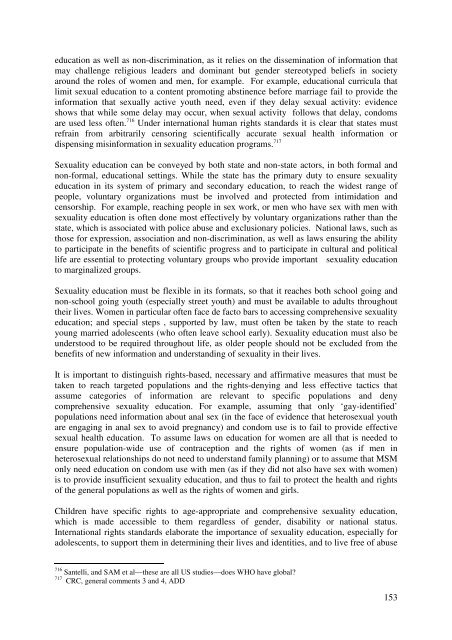SEXUAL HEALTH AND HUMAN RIGHTS A legal and ... - The ICHRP
SEXUAL HEALTH AND HUMAN RIGHTS A legal and ... - The ICHRP
SEXUAL HEALTH AND HUMAN RIGHTS A legal and ... - The ICHRP
Create successful ePaper yourself
Turn your PDF publications into a flip-book with our unique Google optimized e-Paper software.
education as well as non-discrimination, as it relies on the dissemination of information that<br />
may challenge religious leaders <strong>and</strong> dominant but gender stereotyped beliefs in society<br />
around the roles of women <strong>and</strong> men, for example. For example, educational curricula that<br />
limit sexual education to a content promoting abstinence before marriage fail to provide the<br />
information that sexually active youth need, even if they delay sexual activity: evidence<br />
shows that while some delay may occur, when sexual activity follows that delay, condoms<br />
are used less often. 716 Under international human rights st<strong>and</strong>ards it is clear that states must<br />
refrain from arbitrarily censoring scientifically accurate sexual health information or<br />
dispensing misinformation in sexuality education programs. 717<br />
Sexuality education can be conveyed by both state <strong>and</strong> non-state actors, in both formal <strong>and</strong><br />
non-formal, educational settings. While the state has the primary duty to ensure sexuality<br />
education in its system of primary <strong>and</strong> secondary education, to reach the widest range of<br />
people, voluntary organizations must be involved <strong>and</strong> protected from intimidation <strong>and</strong><br />
censorship. For example, reaching people in sex work, or men who have sex with men with<br />
sexuality education is often done most effectively by voluntary organizations rather than the<br />
state, which is associated with police abuse <strong>and</strong> exclusionary policies. National laws, such as<br />
those for expression, association <strong>and</strong> non-discrimination, as well as laws ensuring the ability<br />
to participate in the benefits of scientific progress <strong>and</strong> to participate in cultural <strong>and</strong> political<br />
life are essential to protecting voluntary groups who provide important sexuality education<br />
to marginalized groups.<br />
Sexuality education must be flexible in its formats, so that it reaches both school going <strong>and</strong><br />
non-school going youth (especially street youth) <strong>and</strong> must be available to adults throughout<br />
their lives. Women in particular often face de facto bars to accessing comprehensive sexuality<br />
education; <strong>and</strong> special steps , supported by law, must often be taken by the state to reach<br />
young married adolescents (who often leave school early). Sexuality education must also be<br />
understood to be required throughout life, as older people should not be excluded from the<br />
benefits of new information <strong>and</strong> underst<strong>and</strong>ing of sexuality in their lives.<br />
It is important to distinguish rights-based, necessary <strong>and</strong> affirmative measures that must be<br />
taken to reach targeted populations <strong>and</strong> the rights-denying <strong>and</strong> less effective tactics that<br />
assume categories of information are relevant to specific populations <strong>and</strong> deny<br />
comprehensive sexuality education. For example, assuming that only ‘gay-identified’<br />
populations need information about anal sex (in the face of evidence that heterosexual youth<br />
are engaging in anal sex to avoid pregnancy) <strong>and</strong> condom use is to fail to provide effective<br />
sexual health education. To assume laws on education for women are all that is needed to<br />
ensure population-wide use of contraception <strong>and</strong> the rights of women (as if men in<br />
heterosexual relationships do not need to underst<strong>and</strong> family planning) or to assume that MSM<br />
only need education on condom use with men (as if they did not also have sex with women)<br />
is to provide insufficient sexuality education, <strong>and</strong> thus to fail to protect the health <strong>and</strong> rights<br />
of the general populations as well as the rights of women <strong>and</strong> girls.<br />
Children have specific rights to age-appropriate <strong>and</strong> comprehensive sexuality education,<br />
which is made accessible to them regardless of gender, disability or national status.<br />
International rights st<strong>and</strong>ards elaborate the importance of sexuality education, especially for<br />
adolescents, to support them in determining their lives <strong>and</strong> identities, <strong>and</strong> to live free of abuse<br />
716 Santelli, <strong>and</strong> SAM et al—these are all US studies—does WHO have global?<br />
717 CRC, general comments 3 <strong>and</strong> 4, ADD<br />
153

















